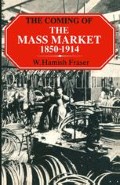Abstract
The sixty years after 1850 saw a flourishing of museums, art galleries, public libraries, of temperance cafés and of halls for ‘improving’ public meetings. There were opportunities for healthy recreation like swimming or cycling or for spectating at football matches and race meetings. Yet, in spite of all of these attractions, the public house remained central to the social life of the mass of the population. In 1852 G. R. Porter declared that ‘no person above the rank of a labouring man or artisan, would venture to go into a public house to purchase anything to drink’, but in this at any rate the example of the middle class was rejected by the working class.
The cheap press, with its ubiquitous correspondents and historians of all contemporary ranks and occurrences in the body politic, has transformed the severely domesticated Briton of both sexes, of all ages, who belonged to a bygone generation, into an eager, actively enquiring, socially omniscient citizen of the world, ever on the outlook for new excitements, habitally demanding social pleasure in fresh forms.
T. H. S. Escott, Social Transformations of the Victorian Age (1897).
Preview
Unable to display preview. Download preview PDF.
Notes and References
D. H. Robertson, A Study of Industrial Fluctuations (1915) p. 197.
M. Girouard, The Victorian Pub (1975) p. 181.
G. M. Wilson, Alcohol and the Nation (1940) p. 101.
J. Vaizey, The Brewing Industry, 1886–1951 (1960) pp. 5–6.
B. Harrison, Drink and the Victorians (1971) p. 325.
A. Andrews, The Whisky Barons (1977) p. 39.
C. Booth, Life and Labour of the People in London: Industry, III, 2nd ser. (1903) pp. 130–1.
J. Bone, The London Perambulator (1925) passim.
Quoted in G. L. Apperson, The Social History of Smoking (1914) p. 167.
B. W. E. Alford, W.D. & H.O. Wills and the Development of the U.K. Tobacco Industry, 1786–1965 (1973) p. 171.
James Walvin, The People’s Game: A Social History of British Football (1975) pp. 56–7.
S. Yeo, Religion and Voluntary Organisations in Crisis (1976) pp. 189–96.
G. B. Wilson, ‘Variations in the Consumption of Intoxicating Drinks in the U.K.’, Journal of the Royal Statistical Society, LXXV (1912) 205.
Wray Vamplew, The Turf (1976) p. 41.
R. Mander and J. Mitcheson, British Music Hall (1974) pp. 21–9.
G. J. Mellor, The Northern Music Hall (1970) passim.
A. Delgado, Victorian Entertainment (Newton Abbot, 1972) p. 79.
J. Walvin, Beside the Seaside (1978) p. 82.
R. J. Cruickshank, The Roaring Century, 1846–1946, pp. 142–3; Asa Briggs, Mass Entertainment: The Origins of a Modern Industry (Adelaide, 1960) p. 15
G. J. Mellor, Picture Pioneers (Newcastle, 1971).
A. E. Harrison, ‘The Competetiveness of the British Cycle Industry, 1890–1914’, Economic History Review, 2nd ser., XXII 2 (1969) 287.
L. J. Franks and H. E. C. Newham (eds), The Port of Hull and its Facilities for Trade (Hull, 1907) p. 204.
S. B. Saul, ‘The Motor Industry in Britain to 1914’, Business History, V (1962–63) 22–44.
James Walvin, Beside the Seaside (1978) p. 38.
G. J. Mellor, Pom-Poms and Ruffles: The Story of Northern Seaside Entertainment (Clapham (via Lancaster) Yorkshire, 1966).
J. K. Walton, ‘The Pursuit of Happiness at the Seaside’, paper given to the Anglo-American Historical Conference, London, 1979.
Tonie and Valmai Holt, Picture Postcards of the Golden Age (1971).
H. and A. Gernsheim, A Concise History of Photography (1965).
R. D. Altick, The English Common Reader (Chicago, 1957) pp. 286–7.
S. Morison, The English Newspaper (Cambridge 1932) p. 251.
F. A. Munby, The House ofRoutledge, 1834–1934 (1934) pp. 41ff.
G. L. Griest, Mudie’s Circulating Library and the Victorian Novel (Newton Abbot, 1970) pp. 176–212.
John Knox, The Masses Without, quoted in John McCaffrey (ed.), Shadow’s Midnight Scenes (Glasgow, 1858; reprinted 1976).
E. S. Turner, Boys Will Be Boys (1957).
Copyright information
© 1981 W. Hamish Fraser
About this chapter
Cite this chapter
Fraser, W.H. (1981). The Nation Entertained. In: The Coming of the Mass Market, 1850–1914. Palgrave, London. https://doi.org/10.1007/978-1-349-16685-5_14
Download citation
DOI: https://doi.org/10.1007/978-1-349-16685-5_14
Publisher Name: Palgrave, London
Print ISBN: 978-0-333-31034-2
Online ISBN: 978-1-349-16685-5
eBook Packages: Palgrave Economics & Finance CollectionEconomics and Finance (R0)

